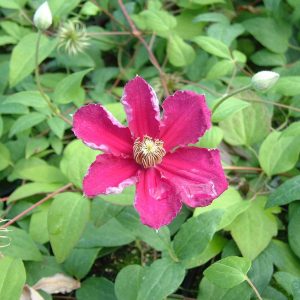Description
Verbascum phoeniceum, commonly known as purple mullein, is a biennial or short-lived perennial plant that is native to Europe and Asia. It has a basal rosette of dark green leaves and tall spikes of purple or pink flowers that bloom in early to mid-summer. The flowers have a distinctive bee-like appearance and are loved by pollinators. The plant prefers full sun to partial shade and well-draining soil, and is tolerant of drought once established. It can reach a height of up to 1 meters and is suitable for borders, cottage gardens, and wildflower meadows. It pairs well with other sun-loving perennials such as salvias, rudbeckias, and echinaceas, and also looks beautiful planted en masse for a striking display of color.
Key Facts
- Common Name(s):purple mullein
- Hardiness:Fully hardy
- How big will I get? Verbascum phoeniceum can grow to a height of 1m and a spread of 0.5m.
- Did You Know That:Verbascum phoeniceum is a self-seeding plant, which means that it will readily spread and naturalize in your garden over time?
Plant Calendar
A rough guide to how this plant will change through the year.
| Jan | Feb | Mar | Apr | May | June | July | Aug | Sept | Oct | Nov | Dec | |
| Flowering Time |  |
 |
||||||||||
| Foliage Colour |  |
 |
 |
 |
 |
 |
 |
 |
 |
 |
 |
 |
| J | F | M | A | M | J | J | A | S | O | N | D |
 |
 |
||||||||||
 |
 |
 |
 |
 |
 |
 |
 |
 |
 |
 |
 |
Care Guide

Soil Requirements
Verbascum phoeniceum prefers soil with good drainage and does not tolerate standing water.Alkaline

Best Position
Verbascum phoeniceum can handle either an exposed or a sheltered position and requires full sun to thrive, this consists of more than six hours of direct sunshine per day.

Maintenance
Verbascum phoeniceum should be deadheaded regularly to promote new flowers coming through. This will prolong the flowering period of the plant as it saves the energy that the plant would have put into producing seeds and allows it to produce more flowers!

Pest, Diseases and Wildlife
Verbascum phoeniceum can have problems with caterpillars, it can be vulnerable to certain diseases such as powdery mildews. It is also known to attract bees and butterflies. It is not considered to be toxic.





